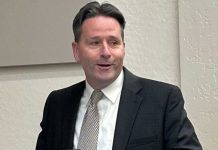Dear Editor,
Recently, a letter writer wrote to the effect that Intelligent
Design, at least as cited by a previous letter writer, is
”
a vessel made of religious crack pottery.
”
I’d like to submit the following data in reply:
Dear Editor,
Recently, a letter writer wrote to the effect that Intelligent Design, at least as cited by a previous letter writer, is “a vessel made of religious crack pottery.” I’d like to submit the following data in reply:
Assume there is a set of parts, A and B, necessary for a functioning organism. If A-B make an organism, but B-A don’t, and all the parts are A or B, then the chances of an organism arising by chance are 1 in 2. (One of two choices is successful, or 1 X 2 = 2.) If three components are needed to come together in a unique sequence to make a living organism, that is, if A-B-C is successful, but no other combination is, there are 6 ways to combine 3 parts, or 1 x 2 x 3 = 6, so the chances of an organism arising by chance is 1 in 6.
With 4 components there are 1 x 2 x 3 x 4 = 24 possible ways to combine the elements. With 5 components there are 1 x 2 x 3 x 4 x 5 = 124 possible ways to combine them. If there are 10 components there are 3,628,800 ways to combine the elements. If an organism had 100 components there would be 10 to the 158th power ways to combine the parts. (That number is written as 1 followed by 158 zeros.) In that situation the probability of an organism arising by chance are 1 in 10 to the 158th power.
Ten to the 158 power is a very large number when you consider that there are only approximately 10 to the 80th power atoms in the entire universe. That’s 1 followed by 80 zeros. If we assume all these atoms are available to form our 100 component organism, 10 to the 78th power (1 followed by 78 zeros) 100 component organisms could be formed at any one time. (10 to the 80th power electrons are available, less 10 to the 2nd power components needed to form a single organism, assuming each component is made of a single atom.) But to be sure we get a 100 component organism with the components connected in the proper sequence, we need to form 10 to the 158th power organisms.
It’s not very likely an organism with 100 components that have to be arranged in a unique sequence are going to be formed in only 10 to the 78th power tries. So let’s assume all the parts can unlink from their unsuccessful linkages, and recombine in a new sequence. Let’s assume the parts can link and unlink a billion times a second in search of the proper sequence.
If the universe is 30 billion years old, that is 10 to the 18th power seconds, and if the parts can make a billion, 10 to the 9th power, switches in a second, that means there is a possible 10 to the 105th power combinations that could be made among all the atoms of the universe in all the supposed history of the universe. (Multiply 10 to the 78th power by 10 to 9th power by 10 to the 18th power. To multiply exponents add the exponents together.) But 10 to the 158th power combinations are needed. To create only 10 to the 105th power combinations, means the chance of coming up with the proper combination needed for our 100 component organism are only 1 in 10 to the 53rd power. That is one chance in a hundred million, billion, billion, billion, billion, billion, billion. Or simply put, no chance at all.
If all the atoms of the universe interchanged with each other at the rate of a billion changes a second for all of time, there has not been enough time to produce a single 100-component organism by pure chance. But, there are no living organisms with only 100 components.
According to NASA, the simplest protein molecule that could be considered alive has at least 400 linked amino acids, and each amino acid is made up of 4 or 5 basic chemical elements, and each chemical element is a unique combination of protons, electrons and neutrons. Ergo, evidence for Intelligent Design.
But I doubt my simple quoting of the mathematical facts will persuade anyone that doesn’t want to be persuaded. Back in 1966 a symposium of evolutionists met at the Wistar Institute in Philadelphia and calculated the probability of life arising by chance.
They came to the conclusion that mathematically speaking it was impossible for life to evolve by chance. But their final declarations said in effect, Wasn’t it wonderful that life had arisen by chance. Their reason for this conclusion? Here we are, alive. We must be here by chance. Their belief was based on their religion, evolution, not their mathematics.
Duane Linstrom, Gilroy












